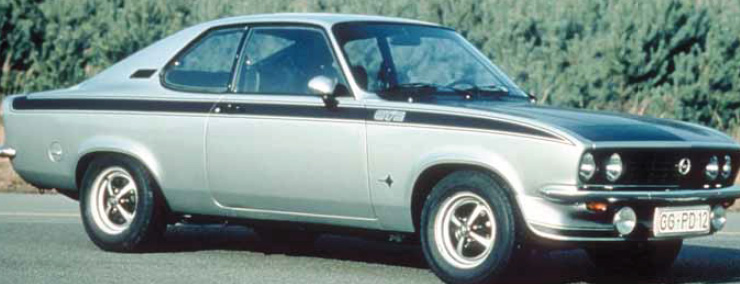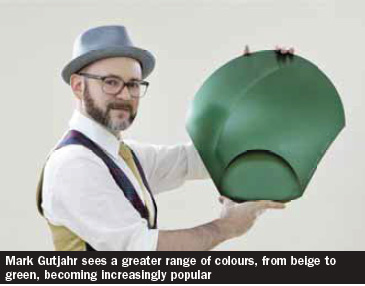 AMS talks to design legend George Gallion and BASF colour designer Mark Gutjahr about colour and style in cars past and present
AMS talks to design legend George Gallion and BASF colour designer Mark Gutjahr about colour and style in cars past and present
For decades, George Gallion was responsible for the appearance of Opel models, including the legendary Manta A series. Gallion recently turned 75 and he still has strong opinions about vehicle colour and design. Recently he paid a visit to BASF Coatings in Münster, a centre of expertise for automotive coatings. Our interview with Gallion and BASF designer Mark Gutjahr (38) on the significance of colours in the automotive sector, revealed that the two designers have a great deal in common.
 APS: George, you once said “When designers dream about their work, then they dream about the future of the automobile.” What exactly do you mean?
APS: George, you once said “When designers dream about their work, then they dream about the future of the automobile.” What exactly do you mean?
Gallion: Being a designer was my dream job. If you want to be a good car designer, you have to love cars. You have to have vision without losing sight of feasibility. And you have to be able to draw. One of my most important tools was my pencil.
APS: Back in 1969, you designed the Manta. What was the most challenging part of designing this car?
Gallion: We wanted to create a product to compete with the Ford Capri, which was launched in the late 1960s, and we wanted to do this as quickly as possible. The Manta entered the market [in September 1970] at almost record speed. The fact that it achieved a certain cult status makes me very proud.
APS: What were you inspired by in your car design work?
Gallion: Many things, for instance, we [the Opel design team] looked around the world of animals, fashion, and, of course, cars and products at trade shows.
APS: And where do you get your ideas for the automotive colours of the future, Mark?
Gutjahr: It’s not so different for us at BASF. We get ideas at furniture and textile shows, as well as from architecture. In  addition, we analyse changes in society and try to develop a sense of the ‘zeitgeist’.
addition, we analyse changes in society and try to develop a sense of the ‘zeitgeist’.
APS: So how does a colour trend become a trend colour?
Gutjahr: It’s the car manufacturers who pick up the colours from our trend forecasts and, in most cases, work with us to refine the colours. This means that we also work very closely with and for the carmakers’ designers.
APS: What significance did colour have for you as a car designer?
Gallion: It was highly significant. A car is like a sculpture. It lives from colour. The finish lends the car its character, and you can work with gloss and effects to get superb results – sometimes!
Gutjahr: That’s fantastic! I agree. Colour also provides the aesthetic appeal of a car. Colours give vehicles their individual touch. And new technical possibilities [new paint formulations] give us new options.
APS: Such as?
 Gutjahr: Our XFine® basecoat. It features strong metallic effects; these can give us an ‘elegant’ silver. Very fine aluminum particles are arranged parallel to each other and thus produce a kind of mirror effect on the body.
Gutjahr: Our XFine® basecoat. It features strong metallic effects; these can give us an ‘elegant’ silver. Very fine aluminum particles are arranged parallel to each other and thus produce a kind of mirror effect on the body.
Gallion: We didn’t have possibilities like these back then. But it was more colourful. I miss the colourfulness of the 1970s and 1980s. I really wish there was more colour on the roads, like a bold orange, or why not lime green?
APS: How does your trend forecast look in this respect, Mark?
Gutjahr: We actually do see a trend toward more colourfulness. Brown has soared to a share of around 6% in a very short time. A greater range of colours, from beige to green, is becoming more popular. It will definitely become more colourful on the roads of Germany.
This can be applied to ‘classic’ designs also; the Opel CD concept car also radiates a brand new gloss in “Candy apple red.” It is considered to be the most beautiful Opel of all time and in 1969 was the star of the IAA in Frankfurt. Using special classic car paints from BASF’s Glasurit brand, it was restored recently…
classic car paints from BASF’s Glasurit brand, it was restored recently…
Gallion: ... and it is dazzling. The car is currently on display at BASF’s Münster site. When I see it here, I am filled with pride and nostalgia.
APS: Whether classic cars or new cars, will colour continue to regain its importance?
Gallion: I think it will. For instance, look at the Opel Corsa Colour Line Edition. It’s the brilliant colours that influence many customers to buy this model.
Gutjahr: Absolutely. Colour conveys the first impression of the car. In addition to the brand and the engine power, colour is becoming increasingly important for car owners. It provides an identity, and depending on the colour, it also lends individuality and, as a result, character.
































